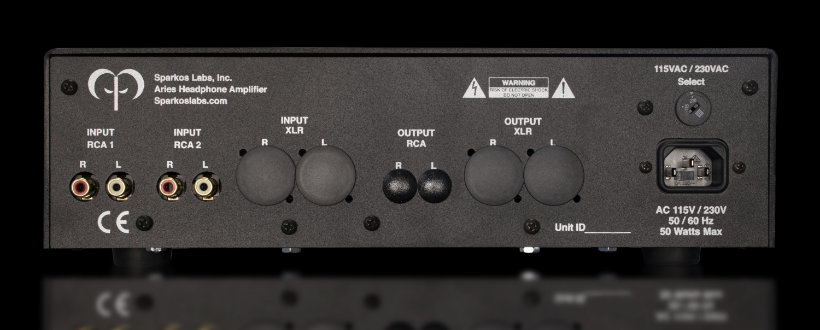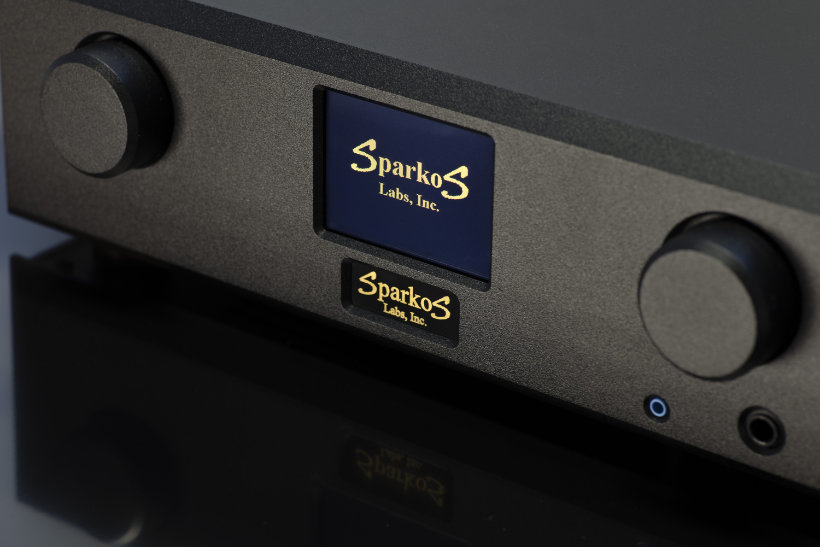Colorado-based Sparkos Labs quietly built a reputation designing high quality, discrete op-amps, voltage regulators and power supplies for other headphone amp manufacturers and DIY upgraders. This is why I was surprised when their recently appointed UK distributor asked if I’d be interested in reviewing the Aries headphone amplifier, which is not only Sparkos’ first retail product but quite possibly the finest headphone amplifier and preamp that mankind has ever known, it says here.
Despite a refreshingly entertaining, tongue-in-cheek marketing strategy that takes a leaf from the book of fellow American manufacturer Schiit Audio, Andrew Sparks has 20 plus years experience working in the electronics industry and clearly knows how to engineer high-performance audio components. His discrete SS2590 op-amps provide more gain and Class A bias than their IC counterparts, have lower distortion and noise, and are designed to be as sonically transparent as possible. While Aries’ uncompromising wire with gain design objective is certainly laudable, superior measured performance doesn’t necessarily equate to subjectively better sound. I was therefore keen to hear for myself whether Sparkos have managed to square the circle in this respect.

Aries is just over a foot square – unusually large for a desktop headphone amp – and has a premium, textured black finish that should stand up well to daily use without becoming a magnet for dust and fingerprints. The central touch display is used to select inputs, change gain and even customise the colour scheme if you wish. The left and right dials adjust balance and volume, these can be swapped via the touch screen so that the most used volume control remains closest to hand wherever the amp is positioned.
Balance and volume are implemented with a reed relay switched 64-step attenuator, 0.1% tolerance thin film resistors provide perfect left and right channel matching across every 1dB step. The balance control mitigates the potentially less than perfect left/right matching in listener’s headphones or hearing, a useful provision that’s all too often missed. A reed relay was chosen to minimise the mechanical switching noise and, having used the amp in a very quiet room, the ‘ticks’ whispered from inside the amp as the dials are turned are not at all obtrusive. Another advantage of the stepped attenuator is a constant, 180Ω output impedance for extremely low noise that is consistent across all volume settings. The Aries’ attenuator apparently produces as much as 22dB less noise than a conventional potentiometer. In fact, the overall noise of the amplifier is just 1.6 microvolts, even lower than the Benchmark HPA4.

With 14V and 355mA peak output capabilities – that’s 0.5 watts RMS into 300Ω and 2.8 watts RMS into 32Ω – Aries isn’t quite as powerful as the HPA4 but will still drive pretty much any headphone to levels beyond what most ears will tolerate. A negligible 0.1Ω output impedance ensures efficient and linear power transfer into all loads, even those with low and variable impedance curves. Gain can be set to +10dB, +20dB or +30dB. When the gain is changed, ten 1dB steps are trimmed from one end of the attenuator and appended to the other. In low, medium and high gain, the volume spans -53dB through +10dB, -43dB through +20dB, and -33dB through +30dB.
The -0dB output level represents unity gain and is the point at which the amplifier’s output voltage equals the source input voltage. If my math holds up, Aries’ maximum output is reached with a standard 2Vrms input by +14dB, the remaining gain effectively accommodates sources with weaker outputs. With a Schiit Yggdrasil (2Vrms) and Chord Hugo 2 (3Vrms) DAC, low gain was a great match for all of my headphones from the easy-to-drive Focal Utopia (115dB/1V) to the voltage-hungry 600Ω version of the Beyerdynamic DT880 (97dB/1V), and the amp’s noise floor remained super silent throughout.
The Base model Aries is headphone-only and offers a total of three single-ended line inputs – two sets of RCAs on the rear and a 3.5mm line input on the front panel for convenient access – it has one front-mounted 6.3mm single-ended headphone output. The Full model adds a set of single-ended pre-outputs plus XLR inputs and XLR pre-outputs, providing preamp functionality to drive a power amp and/or active speakers. Neither model has a 4XLR balanced headphone output. While this may disappoint those who prefer to eliminate the common ground plane, I am increasingly of the view that a well-designed single-ended amplifier can match or even exceed the performance of differential drive when output power isn’t a limiting factor, and it certainly isn’t a limiting factor here.

Those seeking a headphone/preamp to use in a system that isn’t going to be within arm’s reach should also note that neither model comes with a remote. Sparks was dead set on creating an amplifier with the lowest possible noise floor and this meant eschewing conveniences that weren’t critical to its function. This is also the reason why Aries’ control screen is programmed to sleep after a brief period of inactivity, and why its toroidal power transformer is shielded with Mu metal.
The layout of the amplifier’s innards is extremely neat and great care has been taken to place components where noise pickup is minimised. Two pairs of Sparks’ aforementioned SS2590 discrete op-amps make up the input and output stages, and the power supply with 9,400uF capacitance per rail is managed by a pair of SS78XX and SS79XX discrete voltage regulators. The Full model adds SS3601 and SS3602 discrete op-amps to handle the XLR inputs and drive the preamp outputs. For maximum fidelity there are no capacitors in the signal path in either model, potentially harmful DC offsets are instead dealt with by a DC servo. This gives Aries an astonishing 2Hz-350KHz or – to quote canine-obsessed Sparks himself – DC to dogwhistle bandwidth.

I was sent the Base model to review so was neither able to test drive Aries as a preamp nor compare the quality of its single-ended and balanced inputs. That said, I’m still inclined to recommend paying the extra coin for the Full version to those who have sources that deliver superior performance from balanced outputs, even if Aries’ preamp functionality isn’t required. Headphones used for this evaluation include Audio-Technica ATH-ADX5000, Beyerdynamic DT880, Focal Utopia and Sennheiser HD600 and HD650. I began proceedings pairing the Sparkos with Chord’s portable Hugo 2 that I reviewed last autumn, before switching to my reference Schiit Yggdrasil upon its return from being upgraded to Schiit’s latest ‘Unison’ spec USB board. This proved to be a very informative comparison and demonstrated Aries’ exceptional transparency to the source.
Sound quality
Analogue Productions’ 2013 remaster of Counting Crows’ debut August and Everything After strips off the compression and EQ that smothered the original CD and offers a far more organic perspective of this alt-roots rock classic, the perspective that producer T-Bone Burnett most likely experienced at the console as the cuts were being tracked to tape. Aries takes this a step further and moves you out of the control room with Burnett and into the live room with Adam Duritz and his cro(w)nies. It presents an eerily realistic fly on the wall vantage point, combining a crystal clear, three dimensional image that puts plenty of space and air around each player with a pacey and punchy delivery that articulates the fresh, youthful energy of the band perfectly.
Aries easily reveals that the balance of this energy is brighter with Hugo 2 doing DAC duties, leading edges are crisper and upper harmonics are airier. Yggdrasil, on the other hand, delivers richer timbral mass and depth in the lower registers. In ‘Mr. Jones’, the Chord presents Duritz’s enunciations and Bowman’s cymbal strikes with more incision, and Bryson’s guitars with more jangle. Yggdrasil distributes the band’s verve more evenly, the vocals become warmer and the guitars and drums are played with a heavier gauge of pick and stick. Both DACs deliver an ocean of detail – more than I thought either was capable of resolving – and this detail isn’t simply conjured by bringing background information to the fore, a slight of hand that some amplifiers resort to. Aries actually drives down the noise floor of the system to the point where you’re able to hear low-level cues at their intended levels, the dynamic range of the music is effectively increased because you are hearing deeper down into the mix.

Plugging my headphones directly into Hugo 2 for comparison, the presentation – while still fast and fluid – becomes paler and mistier compared to the Sparkos, it doesn’t have the same luminous pop and dynamic slam. This isn’t a slight on the Chord, which is still an excellent headphone DAC/amp, a class-leading one if you consider only portable devices. Aries simply shows the improvements that can be had when performance isn’t constrained by size, functionality and cost. Listen to Telefon Tel Aviv’s IDM masterpiece and headphone torture test, Fahrenheit Fair Enough, and you’ll discover why the Sparkos is such a formidable package. Effortless frequency extension, iron grip and whip-cracking transients; this album is an utterly immersive and riveting listening experience through Aries.
The Sparkos and Chord amps are very alike in their principled unwillingness to sweeten imperfect recordings. If you have a lot of these in your playlists then Aries may not be the wisest choice; a slower amp with some bloom would be more forgiving, especially if your DAC and headphones are already fast and revealing. It depends whether you enjoy taking the rough with the smooth and are brave enough to hear what your music truly sounds like. But I must say that, even when listening to ‘lo-fi’ material, I never had the urge to skip tracks. In the melancholic and gritty ’Found Out About You’ from Gin Blossoms’ New Miserable Experience, the aggressive tones in Leen’s repetitive, tension-building bass riff really cut through to propel the song onward with even more purpose and resilience. Aries delivers music with a clarity and intensity that not only catches but more importantly sustains your interest, and no matter what genre I threw at it I never once felt detached from or uninspired by what I got back.
Verdict
Sparkos Labs’ entry to the headphone market with a such an accomplished amplifier is a remarkable achievement that I hope gains the recognition it deserves. Its ability to deliver forensic levels of detail with a vibrant energy and timbral trueness, all in equal measure, makes Aries an exceptionally well-rounded headphone amp. It dissolves the acoustic barriers between performer and listener better than most, if not all, other solutions at this price.


